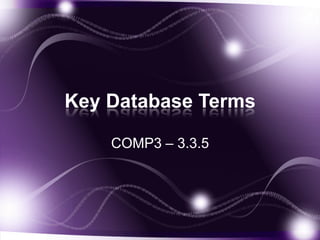Key database terms
•Descargar como PPTX, PDF•
2 recomendaciones•3,484 vistas
Denunciar
Compartir
Denunciar
Compartir

Recomendados
Recomendados
Más contenido relacionado
La actualidad más candente
La actualidad más candente (20)
Destacado
DML, DDL, DCL ,DRL/DQL and TCL Statements in SQL with ExamplesDML, DDL, DCL ,DRL/DQL and TCL Statements in SQL with Examples

DML, DDL, DCL ,DRL/DQL and TCL Statements in SQL with ExamplesLGS, GBHS&IC, University Of South-Asia, TARA-Technologies
Destacado (20)
DML, DDL, DCL ,DRL/DQL and TCL Statements in SQL with Examples

DML, DDL, DCL ,DRL/DQL and TCL Statements in SQL with Examples
Concept of Relational Database and Integrity Constraints [DIFFERENCE BETWEEN ...

Concept of Relational Database and Integrity Constraints [DIFFERENCE BETWEEN ...
Similar a Key database terms
Similar a Key database terms (20)
Chapter 7(documnet databse termininology) no sql for mere mortals

Chapter 7(documnet databse termininology) no sql for mere mortals
Lec20.pptx introduction to data bases and information systems

Lec20.pptx introduction to data bases and information systems
RELATIONAL MODEL OF DATABASES AND OTHER CONCEPTS OF DATABASES

RELATIONAL MODEL OF DATABASES AND OTHER CONCEPTS OF DATABASES
Chapter 5 design of keyvalue databses from nosql for mere mortals

Chapter 5 design of keyvalue databses from nosql for mere mortals
Más de listergc
Más de listergc (20)
Key database terms
- 1. Key Database Terms COMP3 – 3.3.5
- 2. Learning Outcomes • By the end of this lesson; – You will all be able to describe a relational database – You will all be able to define a number of key database terms – You will begin creating a basic Access database
- 3. Relational Database A relational database has more than one table and the tables are linked using key fields. For example, a library database could have three tables: – customer - when a customer joins the library a record is created. It stores their details such as their first name and surname and includes a unique Customer ID. – book - each book in the library has a record. It stores details about the book, such as the author and title and includes a unique book ID. – lending - when a customer borrows a book, the lending table stores the customer's unique ID and the book's unique ID in a record. The record could also include additional information such as when the book was borrowed and when it's due back.
- 4. Relational Database Advantages – The book's details and the customer's details need only be entered into the database once. – Because of this, mistakes are less likely to happen and if there were a mistake in a customer's record, for example, correcting it will correct the mistake database- wide. – Duplication is avoided - this keeps the database's file size down. – Details about books and customers are easily accessible using their unique IDs. – Queries can be performed and reports generated, eg a list of books a customer has borrowed since joining the library.
- 5. Key Terms • Attribute – The field names and data types that are in a database • Primary Key – A unique identifier for a row within a table • Composite key – If there is no unique identifier then a combination of two or more attribute is used to identify the row. • Foreign key – An attribute in a table that is the primary key of another table • Referential integrity – Since there is related data in several tables in a relationship data, updates to one table may require updates to related tables. The need to cascade updates across more than table is called Referential Integrity
- 6. Task 1 • On Jogle you need to; – Describe what is meant by a relational database, using an example. – Define each of the 5 key terms
- 7. Task 2 • You will need to create an Access database for your online gaming website you planned in yesterdays lesson. You should be able to explain where you have used each of the 5 key terms.